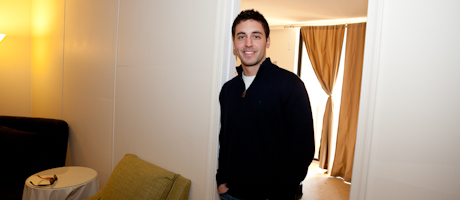By Menachem Wecker
Sometimes good temporary walls make good neighbors.
At least that’s the motivation behind the company WallsDC, which outfits apartments and offices with temporary, pressurized partitions.
Last March, senior James Rothpearl co-founded the company with fellow senior Craig Abramson. When Mr. Abramson left WallsDC last summer, Mr. Rothpearl decided to see if he could run the company himself.
With about 10 to 15 clients a month – about half of them on campus – WallsDC, which employs a construction manager and a part-time staff member, is well on its way, and Mr. Rothpearl says he hopes to lead the company full time after he graduates in May.
According to Mr. Rothpearl, WallsDC provides a unique service to the Washington area.
Mr. Rothpearl says he and Mr. Abramson knew of people partitioning apartments in New York with pressurized walls, but when they sought out similar services in the District when they were apartment hunting, they came up empty.
“We saw a potential need for something like this in the city, because of D.C.’s huge student and young professional population,” says Mr. Rothpearl. “Since we couldn’t get a temporary wall, we looked into what it would take to do it ourselves. One thing led to another, and soon we were getting calls and emails for quotes – lots of them.”
WallsDC has installed the partitions – which Mr. Rothpearl says are “indistinguishable” from regular walls and use no screws or nails – in several apartment buildings in the campus area, including the Statesman, Columbia Plaza, 2400 M Street and the West End Residences.
The walls rely on surrounding structures like adjacent walls and ceilings to create sufficient pressure to stabilize themselves, according to Mr. Rothpearl. “The end result is an extremely strong and sturdy, yet technically temporary structure,” he says.
The walls can support pictures, mirrors and small televisions, and customers can customize them (for additional cost) by adding windows and doors.
“Each of our walls is custom designed for each client and installed carefully on site,” Mr. Rothpearl says. “Since there are no nails or screws involved in the support system of the wall, there is subsequently no damage to any of its surrounding structures.”
The ease with which the walls can be removed allows WallsDC to reuse many of the materials, such as the doors, windows, steel track and studs. “We are essentially recycling any materials that we can. Minimizing the waste from projects ultimately helps the environment,” says Mr. Rothpearl.
Asked how much a typical wall can cost a customer, Mr. Rothpearl cautions that buying a pressurized wall can be like buying a car – the cost depends on the type and the accessories. But he says a “bare-bones conventional sized wall” can cost about $1,200.
“Keep in mind that this $1,200 can save a client $12,000 a year by turning a one-bedroom apartment into a two-bedroom apartment in the Foggy Bottom/West End area,” he says, estimating that a year-long lease typically costs about $2,000 a month. “I think students and younger people need options like this in order to be able to afford D.C.’s high cost of living.”
The business has benefited from a revamped website that makes it easy for users to navigate and submit online quotes, says Mr. Rothpearl, who collaborated with a web designer to polish the site. He’s also using his knowledge of online marketing and social media to make sure the site is optimized for search engines.
Mr. Rothpearl credits his studies at GW and his experiences on campus with helping him decide to co-found WallsDC and his subsequent success.
Spending time with colleagues at GW has “really stimulated” him and encouraged him to pursue the company, says Mr. Rothpearl, who chose to attend GW for its “well-known faculty,” “attractive course offerings” and the “diverse opportunities” a GW education and degree provide.
An American studies major, Mr. Rothpearl says the Columbian College program has afforded him a lot of flexibility, and he has taken courses in media, politics, business, history and computer science.
The business courses in particular seem to have helped.
“Two of the things I learned at GW were to limit overhead and maximize results, and also to be consistently innovative and creative when confronted with a problem,” he says. “These become even more important for new companies.”


